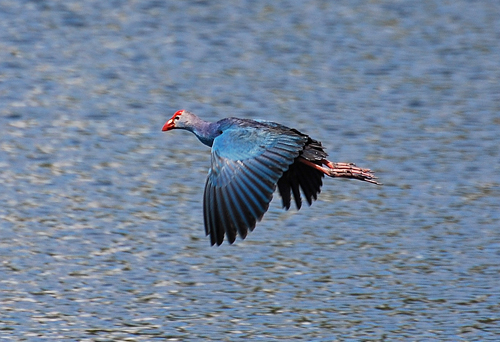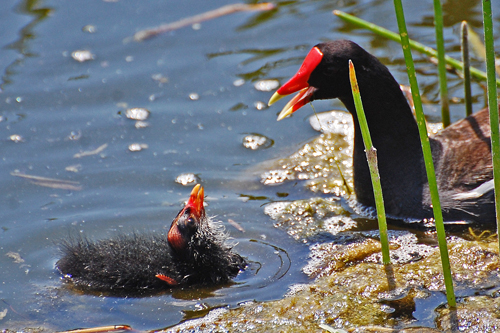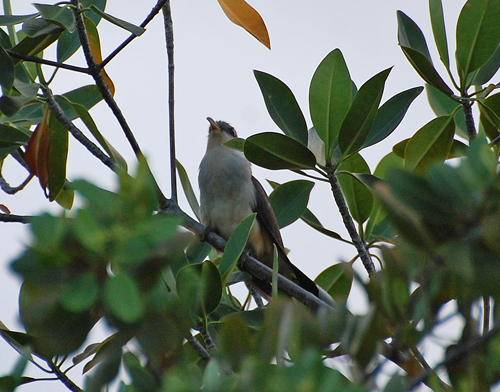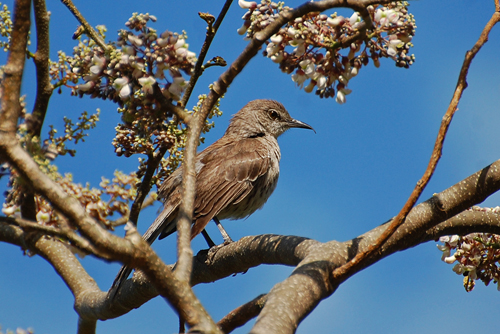I did some homework on my ABA list of North American Birds soon after I tallied number 725. I found that I have seen all of the approximately 490 Code 1 birds, and all but 10 of the approximately 165 ABA Code 2 birds. The next challenge was not long in forming in my brain: top priority for me in 2014 is to see the remaining Code 2 birds, namely, Mottled Petrel, Sooty Grouse, Purple Swamphen, Scripps’s Murrelet, Whiskered Auklet, Mangrove Cuckoo, Black Swift, Bluethroat, McKay’s Bunting and Nutmeg Mannakin.
The only place to find Purple Swamphens and Mangrove Cuckoos is Florida, and the best time for the Cuckoo, is springtime. I decided to make them my first targets. I contacted Chris Newton, an accomplished Florida birder and photographer, to see if he would like to join me to help me find them. He readily agreed, and with his invaluable help, we located both of my target birds. The photos included in this blog were taken by Chris and are used with his permission.
I flew into Orlando and picked Chris up at his home in Kissimee and we drove to Green Cay Wetlands and Nature Center near Palm Beach. What a fine place this is. The wetlands are quite extensive and are unusually accessible by virtue of the impressively long board walk that has been constructed throughout. We searched a long time before finally locating a Purple Swamphen hiding in the tall grass.
A few looks at its head were quite unsatisfactory, but after a while, though at a distance, the bird decided to fly to another area, Chris was able to photograph it, and I was able to follow its flight in my bins as it flew over the open water. The legs were not as red as I expected, so it was probably a youngster. The next day we saw an adult Purple Swamphen flying across some water.

Among the interesting sights along the boardwalk was that of a Black-necked Stilt guarding its clearly exposed nest with 4 brownish eggs, vigorously harassing an approaching and hugely larger Great Egret. She (or he) was joined by several other Stilts as they successfully diverted the Egret from the nest. Life is perilous in the swamp. A few Alligators glided through the open water. Common Gallinules were common, and many of them had chicks.

A young Least Bittern clung to the reeds and seemed oblivious of our presence on the nearby boardwalk.
Target number 1 was in the bag so we decided to get a jump on tomorrow’s effort to find a Mangrove Cuckoo. We drove on south toward and past Miami and explored 2 or 3 likely sites, with no success. As darkness descended, we decided to call it a day, seek shelter and sustenance, and get an early start in the morning. That we did, and by 7:00 a.m. the next morning we were searching the area around Black Point Marina near Miami. We did not have to wait long before a very vocal Mangrove Cuckoo made its appearance and was most cooperative in selecting resting sites that allowed for decent photography.

Having notched numbers 726 and 727 in my North American Life List, we began the long trek back to Kissimee and Orlando, stopping at a few bird-friendly locations on the way. First stop was at Pine-tree Park in Miami-Dade where a rare Bahama Mockingbird had been seen regularly in recent days. As predicted, it was easily located and quite oblivious of the activity around it. This bird, my second Bahama Mockingbird in the last month, is quite drab compared to the one I saw at Key West, and has a malformed upper mandible.

We drove on north to see if we could get a better look at some more Purple Swamphens. We stopped at the City Furniture Pond near Tamarac in Broward County and were soon rewarded with not one, but two Purple Gallinules, including this one foraging in the reeds.

Mission accomplished, I returned home to plan my next foray. I will divert a bit from my primary objective of finding Code 2 birds, in order to try to see the Buff-collared Nightjars (Code 3) recently seen in Arizona [with another attempt at Sinaloa Wren (a Code 5), this time in Huachuca Canyon rather than the one seen earlier this year in Tubac], from whence I will go up to Washington to try again for a Sooty Grouse, (one of my now remaining 8 Code 2 birds) this time looking in the Hurricane Ridge area.
